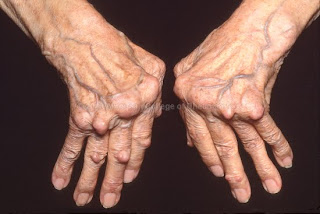Nursing Diagnosis for Rheumatoid Arthritis
Rheumatoid arthritis (RA) is an inflammatory disease that causes pain, swelling, stiffness, and loss of function in the joints. It occurs when the immune system, which normally defends the body from invading organisms, turns its attack against the membrane lining the joints.
Diagnosis of rheumatoid arthritis (RA) – For a long time there was no specific test that would unambiguously confirm the presence of the disease . Currently, diagnosis of disease based on biochemical analysis of blood, changes in the joints are visible on x-rays, and the use of basic clinical markers, but also in conjunction with the general clinical manifestations – fever, malaise, and weight loss
In the analysis of blood examined ESR, rheumatoid factor, platelet count, etc. The most advanced analysis is the titer of antibodies to cyclic citrulline-containing peptides – ACCP, anti-CCP, anti-CCP. The specificity of this indicator is 90%, while it is present in 79% of sera from patients with RA.
Diagnostically important clinical features are the lack of discoloration of the skin over the inflamed joints, the development of tenosynovitis flexors or extensors of the fingers and the formation of amyotrophy, typical strains of brushes, so-called "rheumatoid wrist.
Nursing Diagnosis for Rheumatoid Arthritis: Impaired Physical Mobility
related to:
- skeletal deformity
- painful
- discomfort
- activity intolerance
- decreased muscle strength.
Can be evidenced by:
- Reluctance to try moving / inability to move in with their own physical environment.
- Limiting the range of motion, coordination imbalances, decreased muscle strength / control and mass (advanced stage).
The expected outcomes / evaluation criteria, patients will:
- Maintaining a function of position in the absence / restrictions contractures.
- Maintain or improve strength and function of and / or compensation of the body.
- Demonstrate techniques / behaviors enabling activities.
Nursing Interventions : Impaired Physical Mobility - Rheumatoid Arthritis
1. Keep the rest bed rest / activity schedule to sit if necessary to provide a continuous period and nighttime sleep uninterrupted.
Rationale: Systemic Rest is recommended during acute exacerbations, and all phases of the disease is important to prevent exhaustion maintain strength
2. Evaluation / continue monitoring the level of inflammation / pain in the joints.
Rationale: The level of activity / exercise depends on the development / resolution of inflammation peoses
3. Change positions frequently with sufficient amount of personnel. Demonstrate / aids removal techniques and the use of mobility assistance.
Rationale: Eliminates stress on the network and improves circulation. Memepermudah patient self-care and independence. Proper removal techniques to prevent tearing skin abrasion.
4. Assist with range of motion active / passive, and resistive exercise also demikiqan isometris if possible.
Rationale: Maintain / improve joint function, muscle strength and general stamina.
5. Position with pillows, sand bags.
Rationale: Increase stability (reducing the risk of injury) and required memerptahankan joint position and body alignment, reducing contractor
6. Encourage the patient to maintain an upright posture and sitting height, standing, and walking.
Rationale: To maximize joint function and maintain mobility.
7. Provide a safe environment, such as raising the chair, using the toilet railings, wheelchair use.
Rationale: Avoiding injury due to accidents / falls
8. Use a small pillow / thin below the neck.
Rationale: Preventing neck flexion.
9. Collaboration: consul with physiotherapy.
Rationale: Useful in formulating training programs / activities based on individual needs and identifying tools.
10. Collaboration: Provide foam mat / converter pressure.
Rationale: Reducing pressure on fragile networks to reduce the risk of immobility.
11. Collaboration: give medications as indicated (steroids).
System may be needed to suppress acute inflammation.
